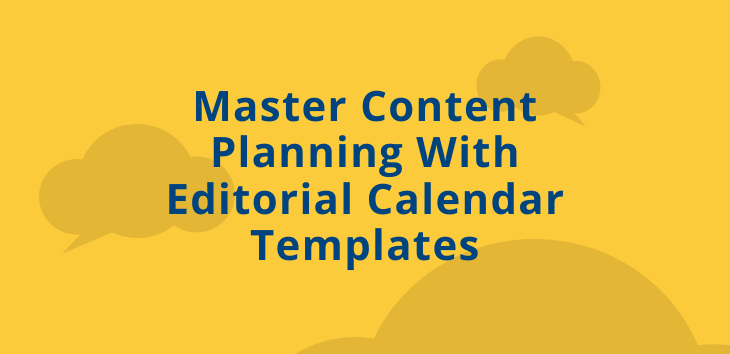
Business goals are the cornerstones of any content strategy. Without established brand messaging, people, search engines, and social media algorithms won’t understand your brand or care about your content. Plus, in the era of multichannel distribution, each piece must be tailored to the various platforms your customers prefer.
Using editorial calendar templates is the only way to make it happen. It creates structure, enabling you to publish consistent, quality content and keep your brand at the top of customers’ minds.
Consumers’ thirst for content is limitless. If you deliver value and know your audience, you can reach them. But if you don’t publish enough to keep them hydrated, they quench their curiosity elsewhere. Here’s our guide to creating, implementing, and maintaining an editorial calendar.
Components of an Editorial Calendar Template
From evergreen articles to seasonal campaigns, you can tailor an editorial calendar template to back your brand’s goals. Let’s look at the essential components:
- Content type: From blog posts to social media updates and email newsletters, editorial calendars accommodate various content types. This versatility ensures you attract a broad audience.
- Publication dates: Stay on track with scheduled publication dates to maintain engagement and visibility for all team members. Flexibility is key here, allowing you to adapt to shifting priorities and seasonal trends.
- Channels: Specify where each piece of content should be published to ensure a cohesive schedule across all platforms.
- Viral opportunities: Anticipate and capitalize on viral moments by aligning your content with industry events and trending topics. Forward planning prevents last-minute scrambles.
- Responsible team members: For complex projects, incorporate a simple RACI chart detailing roles and responsibilities. This streamlines collaboration and creates accountability within your team.
- Status: For straightforward projects where designated roles are established, use status columns to indicate the production stage of each order. As the statuses shift, collaborating team members are notified it’s their turn to step in.
- Content brief: While the project brief’s instructions apply to the content type as a whole, each piece typically pairs with a content brief. Content calendars simplify the review process, so why not provide all the resources in one spot?
Why every content team needs a template
Proactivity delivers better results than reactivity. Planning content a week ahead of time doesn’t leave wiggle room for shifts in your marketing strategy, which is likely to change occasionally. But there’s more to it than punctuality. Here are more benefits of using an editorial calendar:
- Improved organization: Centralizing content planning and scheduling helps your team stay on track with content goals.
- Enhanced collaboration: Clear assignment of roles and responsibilities fosters better collaboration among team members, reducing confusion and doubling-up of efforts.
- Consistency: A structured editorial calendar ensures a consistent publishing schedule, which is essential for maintaining audience engagement and brand credibility and surfing the elusive algorithms.
- Strategic alignment: Editorial calendars enable teams to align content with marketing objectives by providing high-level overviews of how each piece of content contributes to business goals.
An editorial calendar brings order to chaos. If you’re always chasing your tail, going from ideation to strategy to publication, you need a template. Download our editorial calendar template, and breathe a sigh of relief.
How to Craft an Editorial Calendar Template
If only content creation were as easy as hiring a skilled writer and asking them to create an article for you. Your brand strategy, business goals, ideation, and content strategy must be watertight long before pen meets paper. This requires relentless attention to detail and a deep knowledge of your audience’s pain points.
Brand strategy comes first
Your brand must have a clear identity, including unique personality, tone, values, and objectives. Next, craft a brand story that speaks to your audience’s desires, fears, and aspirations. With a brand strategy firmly in place, you never run out of content ideas or post articles that misalign with business goals.
Step-by-step guide to crafting an editorial calendar
Here’s a step-by-step guide to creating an editorial calendar:
- Define goals and objectives. Nail down your goals and objectives, whether they’re boosting brand awareness or driving leads. Your editorial calendar should be laser-focused on your targets.
- Research your audience. Get to know your audience inside and out. Dive deep into demographics, preferences, and pain points to tailor your content accordingly.
- Ideate and plan the content. Brainstorm content ideas for the upcoming year that hit the mark with your audience and brand messaging and nod to potential viral moments.
- Map ideas onto your content calendar. Once you have a pool of content ideas, map them out on your editorial calendar. Consider seasonal relevancy, industry trends, and key events that may impact your audience’s interests.
- Be specific. Allocate dates for each piece of content, ensuring a balanced mix of topics and formats each month. This helps you maintain engagement and motivates your audience to return for more.
- Initiate content creation and collaboration. Assign tasks to your team and ensure everyone knows their role and deadlines. Collaboration is key here — writers, designers, and stakeholders should all be on the same page.
- Start to publish and distribute the finished product. It’s time to get your content out there. Determine the best channels and timing for publication, maximizing your reach and engagement.
- Maintain flexibility. Allow space for spontaneous content opportunities and last-minute adjustments to accommodate changes in your marketing strategy or the industry landscape.
- Monitor your content’s success and optimize early on. Keep a close eye on your content’s performance using tools like Google Analytics. Track metrics such as impressions and organic traffic to fine-tune your editorial calendar.
SEO integration within your calendar
As Google’s algorithm grows ever more sophisticated, SEO becomes increasingly important. You’re not just optimizing content to meet a few criteria anymore — search algorithms expect high-quality, people-first content that delivers value.
Here’s how to weave SEO into your editorial calendar:
- Keyword mapping: Make sure each piece strategically targets specific keywords to enhance its visibility in the SERPs. Use keyword research tools and allocate relevant phrases to each piece on your editorial calendar. Consider search volume, competitiveness, and how the phrases fit into the marketing funnel to pinpoint search intent.
- Content mapping: Harmonize your editorial calendar with content mapping exercises. Identify topics and themes that resonate with your audience and integrate them into your calendar for a cohesive SEO strategy.
- Content gap analysis: Identify gaps in your content coverage using SEO tools and analytics. Schedule content ideation sessions to address gaps so you can capture untapped search opportunities.
- Topic clusters and pillar content: Consider organizing your calendar around topic clusters and pillar content. Identify core topics and supporting subtopics to create a cohesive content ecosystem that strengthens your website’s topical authority.
- Seasonal planning: Capitalize on seasonal trends and search queries when crafting your editorial calendar. Embed timely themes related to seasonal events, holidays, and industry trends to leverage spikes in search traffic.
- On-page optimization schedule: Incorporate on-page optimization directly within your editorial calendar. Assign specific time slots or deadlines for optimizing metadata, headers, and other on-page elements.
Infuse your editorial calendar with SEO best practices so your content attracts more organic traffic and solidifies brand authority online.
Best Practices for Implementing Your Editorial Calendar
Looking for ways to level up your editorial calendar game? Follow these editorial calendar best practices to drive organic traffic and establish your brand as a force to be reckoned with.
Collaborative excellence
Forge strong cross-functional partnerships within your team to drive collaborative content planning. Reward experimentation and creativity whenever possible to demonstrate you embrace bold ideas and innovative approaches.
Data-driven insights
Regularly cast a keen eye over key performance indicators to determine areas for improvement. Use these insights to guide future content decisions, prioritizing initiatives with the highest ROI.
Experiment with A/B testing to gauge perception and optimize engagement. Keep refining your approach based on this type of solid evidence, focusing on strategies that deliver tangible results.
Content repurposing and amplification
Breathe new life into content through strategic repurposing. Locate the timeless gems within your content library and reshape and revitalize them to reach fresh audiences. You can even repurpose content for different social platforms to extend your content’s reach.
For amplification, play with diverse multimedia formats, such as videos, infographics, and podcasts, to cater to varied preferences and consumption habits.
Stellar’s Downloadable Editorial Calendar Template
Designed to streamline your planning process and maximize efficiency, our template is your ticket to organized and strategic content creation.
How to use your downloadable template
Getting started with our editorial calendar template is a breeze. Navigate to the resources section of our website or scroll to the bottom of the page, where you’ll find the template available for download. Once downloaded, open the file using your preferred spreadsheet software, and you’re ready to roll.
The template is intuitively designed, with clearly labeled sections for content type, publication dates, channels, viral moments, responsible team members, and more. Input content ideas, deadlines, and team assignments, and marvel as your content strategy comes to life.
Customizing Stellar’s editorial calendar template
What sets Stellar’s template apart is its flexibility and adaptability to various content strategies. Whether you’re a solopreneur managing a blog or a marketing team overseeing multiple campaigns, you can tailor our template to suit your needs.
Customization options abound, allowing you to add or remove columns, adjust date formats, and personalize categories to align with your brand’s unique requirements. Need to incorporate SEO keywords or track content performance metrics? Our template can accommodate it all.
Say goodbye to scattered content planning and hello to a results-driven strategy.
